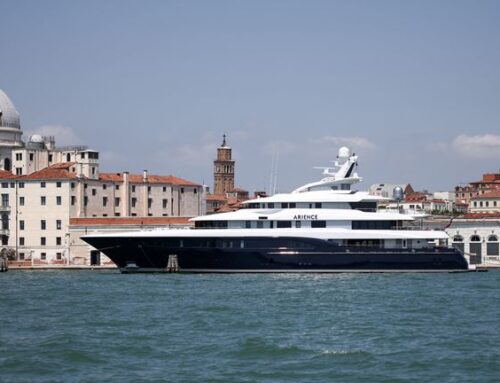I tested Sony’s 360 Virtual Mixing Environment at Battery Studios — here’s how it works
June 24, 2025
At rush hour on a Tuesday evening, I walked through the buzzing Manhattan streets to enter a quiet room at Sony’s Battery Studios for a private session. I sat in the chair in the middle of the room, surrounded by 14 Genelec loudspeakers and two subwoofers, as the audio engineers placed the tiniest microphones I’ve ever seen into my ears.
“They have the capsule facing outwards. Literally taking the measurements of how sound enters into your ear canals,” said Isaac Rodrigues. As the manager of technical partnerships & professional support at Sony Audio, he’s measured the listening experiences of people of all shapes and sizes.
With my head facing the centre speaker, staying very still, I listened to pink noise and sine waves firing from all direction. “Almost there—we just have the headphone measurement left,” said Rodrigues, prompting me to put a pair of Sony MDR-MV1 headphones on. He played the same series of sounds, and I wondered how I could hear them almost exactly as I did before. Turns out, the speakers were muted the second time around. My customised headphone profiling for Sony’s 360 Virtual Mixing Environment (VME) was already complete.
To double-check the placement of each channel in my headphones, I listened to recordings of spoken words coming from various directions. Next, the spatial audio mix of Daft Punk’s Get Lucky started to play. I removed the headphones, and the monitors were unmuted almost immediately to ensure an accurate A/B test. Though I could hear the sub-bass better through the speakers, the difference felt nearly indiscernible. Unsure, I put the headphones back on. I could sense the artificial quality of the ambience ever so slightly—or was I trying too hard to find fault? The comparison felt so surreal that halfway through the song, I was already doubting my ears.

Then, I began pondering the technical aspects of the technology. In a room where phase cancellation issues were almost non-existent, these measurements could produce transparent digital results. But not everyone has access to a treated room at Battery Studios. And, even if they did, wouldn’t they miss the other environments they’re more familiar with?
Apparently, that’s exactly why many 360 VME customers request multiple profiles at once. Some even get their headphone measurements done in their cars for use as a preset on days when they fly out of town. Professional mixing and mastering engineers like the idea of encapsulating the spaces they’re used to.
“We work with people who want to either take their studio with them or mix in immersive formats, but don’t always have access to a studio,” explains Rodrigues. “Especially in schools where students are fighting for studio space—we measure the students at the studio, and then, they can do some of their mixing in their dorm rooms with their headphones”. Sony claims it’s already held sessions at Drexel University, Ithaca College, and the University of Toronto, among other campuses.
For now, the public 360 VME measurement services are handled by ASG and GC Pro in North America. Sony says it’s planning to expand its reach beyond the US, Canada, and Japan soon.

If you’re interested in custom profiling, you’re advised to bring your headphones to the session for best results. You’ll get a copy of the software with your specific measurements summed into a preset. Rodrigues cautiously agrees that any pair of flat open-back studio headphones would work. But, unsurprisingly, he insists that Sony’s MDR-MV1 headphones are the best fit for 360 VME.
The resulting virtual mixing environment functions as a receiver rather than a spatial audio renderer. For example, the Dolby Atmos Renderer can render up to 128 inputs down to a binaural format. You could listen to a mix that complex through the 360 VME standalone software. But you’d still have to tweak it in Dolby Atmos when needed.
Likewise, you can use 360 VME to hear your stereo mixes in the environment where you got your headphone measurements. In such cases, choosing 360 VME as the output setting of your DAW would be the way to go. After that, you could still pick your audio interface as the output device within the 360 VME app.
That may seem like one too many steps to follow, but Sony is not alone in its hyper-realistic audio ventures. While many tech giants equate virtual reality with visual elements, the audio component is also expanding.
Not too long ago, Steven Slate Audio introduced the VSX Headphone Mixing System, which promises the sound of “perfectly tuned pro studio speakers, car systems, clubs, and more”. Sonarworks offers the Virtual Monitoring Add-on that aims to deliver “the most accurate spatial simulation of stereo studio monitors on your headphones”. It might be worth a try, especially if you already enjoy the rest of their SoundID Reference bundle. Similarly, Waves Audio targets EQ correction for specific brands of headphones with its Nx – Virtual Mix Room over Headphones plugin, to bring the listener closer to the experience of mixing with studio monitors. Lewitt Audio’s Space Replicator takes this concept one step further by presenting a diverse range of virtual mixing rooms.

But these products don’t offer the customised immersive experience Sony does with its 360 VME software and MDR-MV1 headphones integration. Any manipulation on sound placement, EQ, or room size to simulate the experience of listening through loudspeakers colours the listener’s perception. That said, how accurate can the tech really be outside of a tested space like Battery Studios? That’s still up for debate.
At the very least, Sony’s 360 VME stands out as a product that respects not only the integrity of your room but also your exact position inside it. While no virtual mixing room may fully replicate the real thing for now, 360 VME is a promising step toward making immersive mixing more portable. And more personal.
SIRMA is an Istanbul-born, New York-based artist, songwriter, and producer. With her distinctive vocal textures, she bends her sound across genres—from pop and electronic to ambient and cinematic soundscapes. Outside the studio, she writes for MusicTech and Roland Articles, diving into the creative and technical sides of music production.
Get the latest news, reviews and tutorials to your inbox.
Search
RECENT PRESS RELEASES
Related Post





